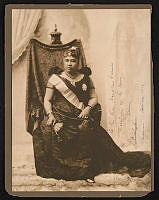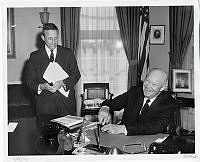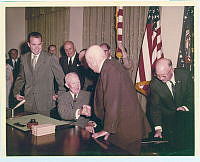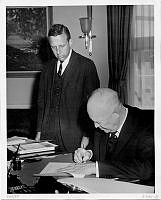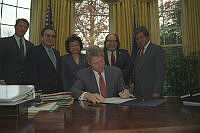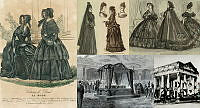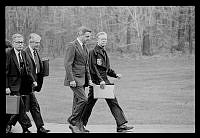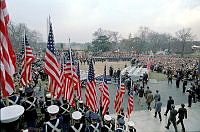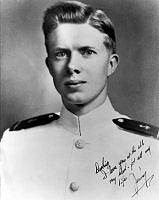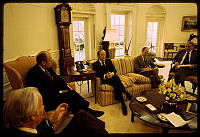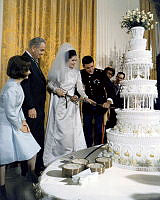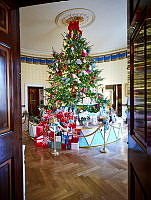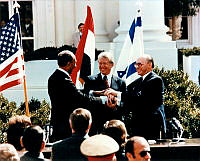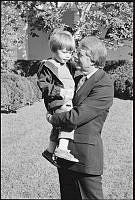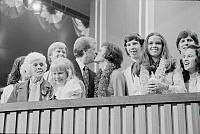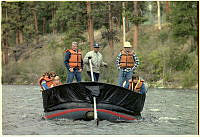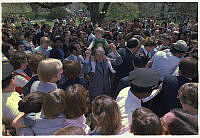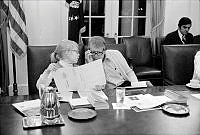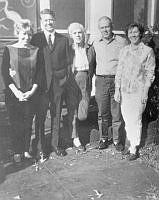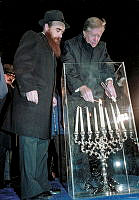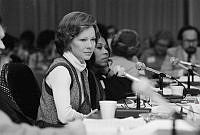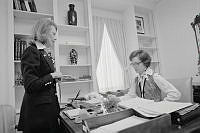Rubenstein Center Scholarship
Pennsylvania in the White House
Pennsylvania only has had one official representative in the White House: President James Buchanan, whose administration lasted from 1857 to 1861. The state’s influence on the building and its tenants has nevertheless been profound, from its construction in the 1790s to the present day.
Philadelphia served as the capital of the United States from 1790 until 1800, spanning both of George Washington’s two terms as president and most of John Adams’s one term. Architect James Hoban met with Washington in Philadelphia in June 1792 and discussed plans for the construction of the White House. Some of the men who worked on the White House during its construction hailed from Philadelphia, and some building supplies were manufactured or purchased there as well. George Washington traveled down the aptly named Pennsylvania Avenue to visit the unfinished building in 1797. And when John Adams moved into the White House in 1800 he brought many of his furnishings and servants from the President’s House in Philadelphia.1

Benjamin Henry Latrobe
White House Collection/White House Historical AssociationEnglish architect Benjamin Henry Latrobe came to Philadelphia in 1798 and lived there for five years. He had a significant impact on architecture in the city, designing the Bank of Pennsylvania and Water Works as well as a number of private residences in southeastern Pennsylvania. President Thomas Jefferson appointed him Surveyor of Public Buildings in 1803. While in Washington, D.C., Latrobe oversaw construction of the United States Capitol as well as St. John’s Episcopal Church and Decatur House. He also made a number of modifications to the White House itself under Jefferson’s direction, including to the roof, staircase, and several rooms. He also added the east and west wings, giving the White House its colonnades that still exist today. After some time working in Pittsburgh, Latrobe returned to Washington, D.C., after the destruction wrought by the British in 1814 and played a preliminary role in the city’s—and the White House’s—reconstruction. Again, many of the workers and material for the rebuilt White House came from Pennsylvania.2
James Buchanan took the Oath of Office on March 4, 1857. He had been born in 1791 near Mercersburg, Pa., and later settled on the estate Wheatland in Lancaster County. While president, he vacationed at Bedford Springs Resort. The only U.S. President who never married, Buchanan relied on his niece Harriet Lane, who hailed from Franklin County, Pa., to manage public and social events in the White House, earning her the title of unofficial First Lady. Although Buchanan made no major changes to the White House during his administration, Harriet Lane bought a number of new furnishings from Pennsylvania, including chandeliers that she purchased from the Philadelphia firm of Cornelius & Baker.3

President James Buchanan
Library of CongressAlthough Harriet Lane is the only person from Pennsylvania to serve the role of “First Lady”, Vice President George P. Dallas, who served from 1845-49, represented the state; and Joe Biden was born in Scranton. However, numerous Pennsylvania state representatives have visited the Executive Mansion over time, and many White House staff members originally hailed from the state.
The Pennsylvania Dutch—actually Germans who settled in the state from the seventeenth century—have bequeathed several White House tenants. Grover Cleveland, Theodore Roosevelt, Warren G. Harding, and Herbert Hoover all had Pennsylvania German ancestry.4 None, though, stayed as close to his roots as President Dwight D. Eisenhower, who served as President of the United States from 1953 to 1961.

Acting “First Lady” Harriet Lane
Library of CongressBorn in Texas and raised in Kansas, but largely of Pennsylvania Dutch ancestry, Eisenhower often visited the state before his term as president. He even served at Camp Colt near Gettysburg as a tank commander in 1918. In 1950, Ike and his wife Mamie began looking for a country home in Pennsylvania and finally settled on a 189-acre estate with an 1887 barn, near Gettysburg.
During his presidency Ike and Mamie spent hundreds of days at their farm, renovating the house, raising animals, barbecuing, watching TV, and even painting. Ike played golf at the nearby Gettysburg Country Club. White House staff spent a good deal of time there as well, as did cabinet members, visiting foreign dignitaries, and the press corps—prompting some to call the estate a second Camp David.5 The farm has since become the Eisenhower National Historic Site.
While other states in the union have wielded greater influence on the presidency and the White House, Pennsylvania has left its mark, both in the construction of the building and in providing a home away from home for one of the twentieth century’s most important presidents.

The Eisenhower Farm in Gettysburg, Pennsylvania
Library of Congress






